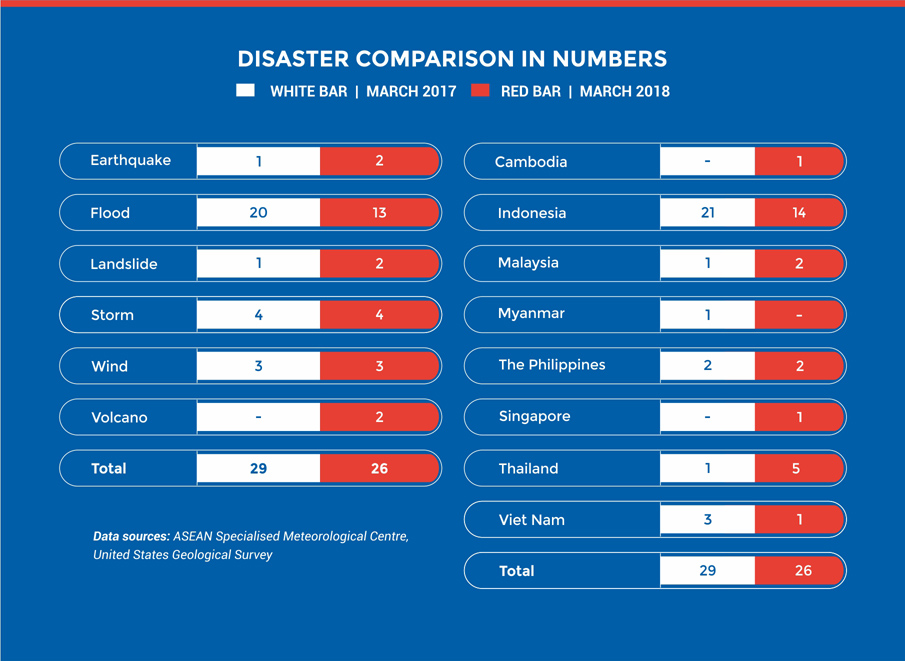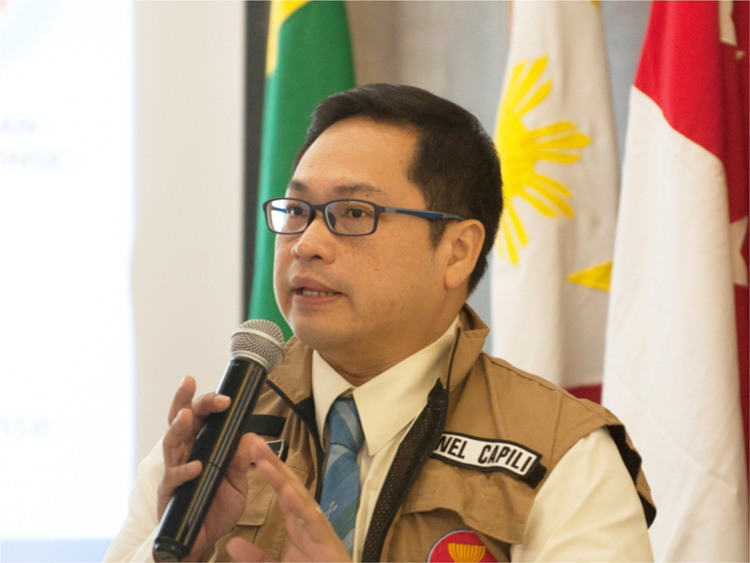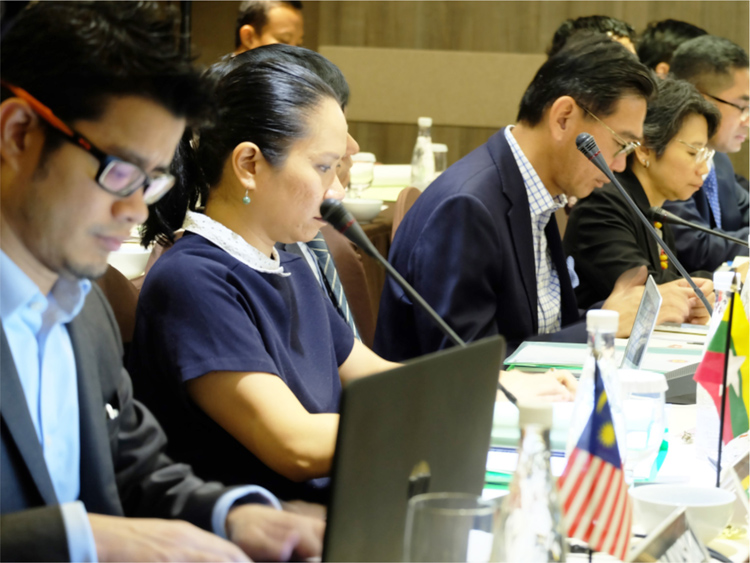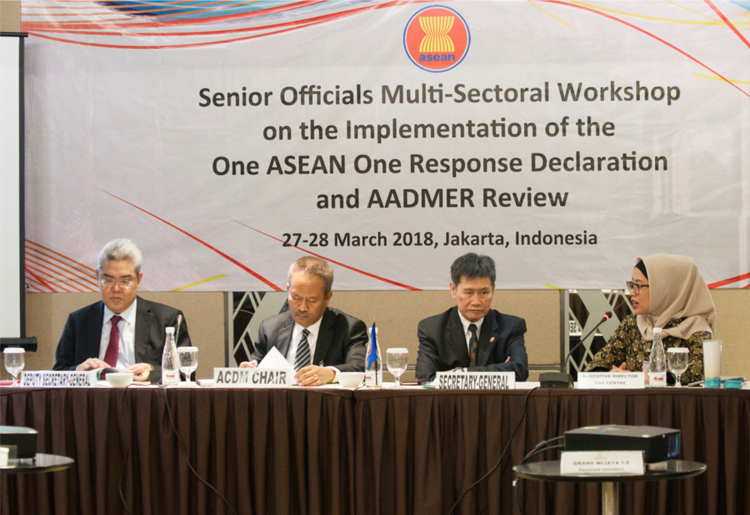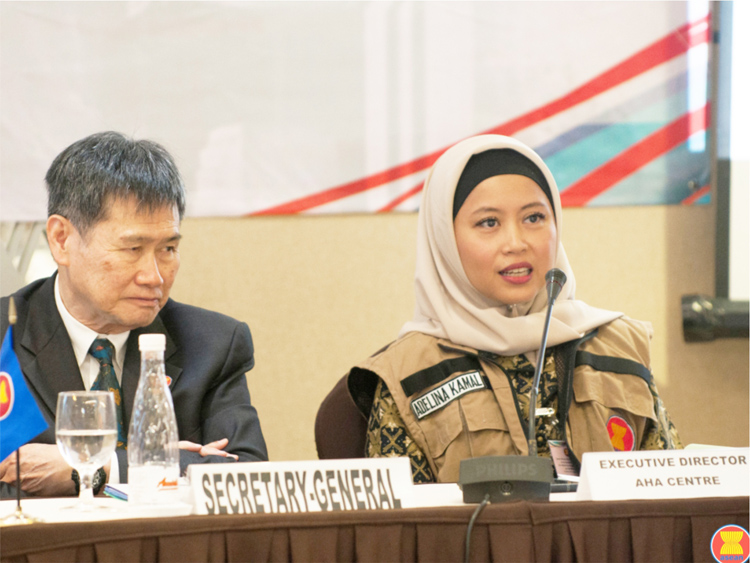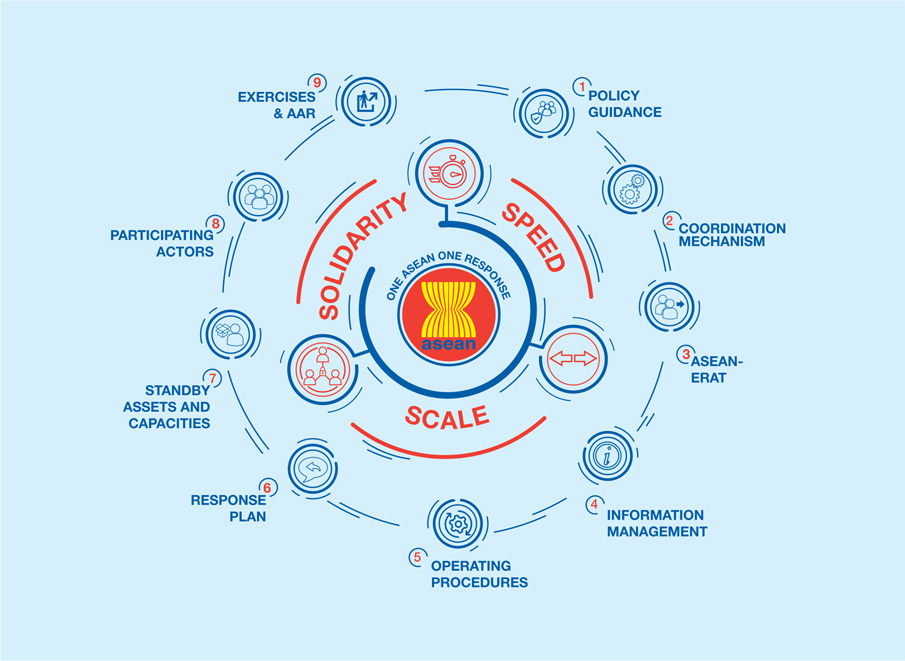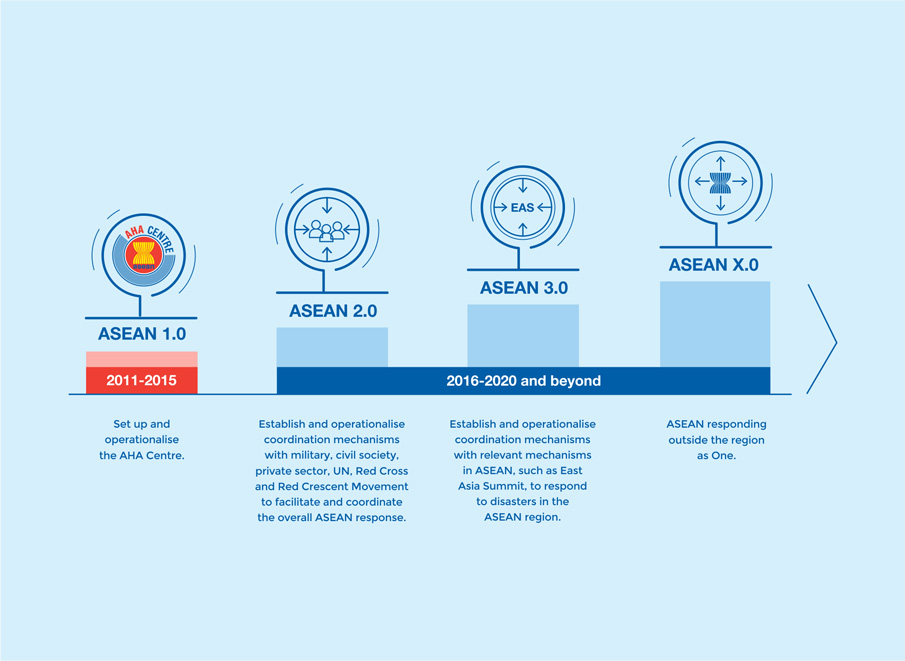Vol 37-Thailand

THAILAND
Thailand is often known as the heart of Southeast Asia, as it lies in the centre of the ASEAN Region, sharing borders with Cambodia, Lao PDR, Malaysia, and Myanmar. The nation is home to a variety of geographical features – including mountains, flatlands, coastal regions, rivers and wetlands – with its proximity to the equator ensuring a hot and steamy climate throughout most of the year, with a climate controlled by tropical monsoons.
While the risk of natural disaster in Thailand is generally lower than the rest of the ASEAN nations due to land masses in the east providing protection from typhoons, and the fact that the country does not lie on a tectonic plate boundary – the interaction between humans and the environment often sees Thailand experience high occurrence of disaster from natural hazards. Floods, drought and landslides disasters are often the result of this complex interaction between humans and their surrounds.
FLOOD
Without doubt, flood forms the greatest natural hazard to Thailand and its citizens, with all regions throughout the country prone to experiencing disaster events and damages due to flooding. There is flash-flooding in the river basins of the south and central deltas, monsoonal floods in Thailand’s coastal regions, and flooding in mountainous areas as the arid land struggles with absorbing the rain caused by unstable mountainous weather systems. High numbers of communities living along the nation’s rivers and coast often feel the full force of these yearly occurrences. Between 1987 to February 2018, Thailand experienced 77 flood events, impacted the nation’s population and economy.
DROUGHT
Accelerated by the impact of a changing climate, drought events have become increasingly prevalent in Thailand, particularly in the nation’s central and eastern regions. The months between January and May often see drought conditions become increasingly severe, as communities await alleviation through the onset of the monsoon season. Drought in Thailand has a significant impact on the nation’s agricultural industry, and consequently can affect the country’s food supply and economy. Alongside this, weather anomalies have also resulted in severe drought emergencies. For example, El Niño in 2014 impacted over 20,000 villages in Thailand’s north, having a run-on effect to agricultural production, food supplies and the nation’s economy.
LANDSLIDE
Landslides form a significant hazard for Thailand’s mountainous northern and eastern regions, as the struggle between arid lands due to the dry season and the onset of monsoonal rains plays out. This struggle often results in large and unexpected landslides, at times amplified by the existence of land degradation due to deforestation. With such events occurring in more remote, mountainous locations, vulnerable populations tend to be from rural commu-nities, and impacts are often further accentuated due to poor building practices within these remote villages. 2011 saw Thailand’s worst landslide event, with an entire village engulfed by mudflow, with 110 residents lost their lives due to the unexpected natural disaster.
Written by : William Shea
All information sourced from ‘Viet Nam Disaster Management Reference Handbook: 2015’, as developed by the Center for Excellence in Disaster Management and Humanitarian Assistance (CFE-DM).
- Published in Insight
Vol 37-Monthly Disaster Outlook

MONTHLY DISASTER REVIEW OUTLOOK
MARCH 2018 | DISASTER MONITORING & ANALYSIS
(DMA) UNIT, AHA CENTRE
GENERAL OVERVIEW OF MARCH 2018
Hydro-meteorological disasters, particularly floods, strong winds and storms, continued to dominate disaster occurrence figures in March 2018. During the month, flash-flooding events due to extreme rainfall within a short amount of time, occasionally triggering landslides as a secondary disaster, as evident in several events across Indonesia. Localised strong winds and storms caused damage in Cambodia, Singapore, Thailand and Viet Nam.
In terms of geological hazards, moderate-to-strong earthquakes (≥ M 5.0) were observed in Indonesia, Malaysia and the Philippines, triggering minor local disruptions without having a significant impact on communities. The ASEAN Earthquake Information Center (AEIC) recorded four earthquakes with a magnitude stronger than M 6.0, three of these-originating in Papua New Guinea – were felt as far across as the Papua Province of Indonesia. Volcanic activities of Mount Mayon in the Philippines continued to affect more than 90,000 people in the nearby Albay Province. On Mount Sinabung, Mount Ijen and Mount Dieng (in East and Central Java provinces Indonesia), toxic gas releases were recorded, and while there were no significant eruptions, the release on Mount Ijen prompted a mandatory evacuation of local communities.
OUTLOOK FOR APRIL-MAY 2018
According to the ASEAN Specialised Meteorological Center (ASMC), the April-May 2018 season can expect slightly below-normal to near-normal rainfall. This is forecasted for most parts of Southeast Asia, except the Philippines. During April 2018, slightly above-normal rainfall is forecast over the northern regions of Kali-mantan and Sulawesi, and western parts of Papua in Indonesia. Towards May 2018, slightly below normal rainfall is expected for most parts of Kalimantan (Indonesia, Malaysia and Brunei Darussalam), Sumatra, Java, Bali and the Nusa Tenggara archipelago of Indonesia. ASMC also stated that there is around 60% chance of La Niña conditions lasting until to end of April 2018, and then a return to neutral conditions during May.
Indonesian Centre for Volcanology and Geological Disaster Mitigation PVMBG states that for April 2018, areas in western Sumatra, south of central Java, north-eastern Borneo, eastern Sulawesi and northern Papua will be prone to ground movement inducing, landslide events. Continuous monitoring for potential humani-tarian consequences will also be required due to the activity of Mount Sinabung (‘PVMBG’s arlet level: warning) and Mount Agung (‘PVMBG’s arlet level: watch) in Indonesia, as well as Mount Mayon and Mt. Kanlaon (PHIVOLCS’ alert level 2, – moderate level of unrest) in the Philippines. Moderate-to-strong earthquakes are still expected in the bordering region between Papua (Indonesia) and Papua New Guinea.
Written by : Mizan Bisri, Qing Yuan Pang
DISCLAIMER
AHA Centre’s estimation is based on data and information shared by National Disaster Management Organisations (NDMOs) and other relevant agencies from ASEAN Member States, international organisations and news agencies. Further information on each recorded-significant disaster, description and details of data and information are available at: http://adinet.ahacentre.org/reports.
- Published in Monthly Disaster Outlook
Vol 37-ASEAN Workshop on The Implementation of ONE ASEAN ONE RESPONSE

ASEAN WORKSHOP
ON THE IMPLEMENTATION OF ONE ASEAN ONE RESPONSE
Remaining focused on responding to natural disasters in the ASEAN region, alongside planning for facilitating potential collective ASEAN responses outside of the region form the key recommendations for the AHA Centre. These points were deliberated by participants of the ASEAN Senior Official Multi-Sectoral Workshop on One ASEAN One Response, organised by the ASEAN Secretariat, from the 27th to 28th of March 2018. Representatives from a wide range of ASEAN sectoral bodies attended the workshop, including from the Country Permanent Representatives (CPR), the ASEAN Committee on Disaster Management (ACDM), representatives from the Senior Official Meeting (SOM), ASEAN Defense Senior Official Meeting (ADSOM), Senior Official Meeting on Health Development (SOMHD), Senior Official Meeting on Social Welfare and Development (SOMSWD), as well as other relevant ASEAN entities and partners.
The principal purpose of this meeting–as highlighted by the ASEAN Secretary-General H.E. Lim Jock Hoi during his opening address–was to engage the views of a range of stakeholders in more prominently defining the functions of the Declaration, as well as providing clarity to requirements for current and future humanitarian challenges faced by the ASEAN region.
The One ASEAN One Response Declaration, signed by the ASEAN Leaders in 2016, reaffirms the commitment of ASEAN nations to respond collectively to major disasters in the region as one, in order to achieve faster speed, greater resources and stronger coordination. It also reaffirms the position of the AHA Centre as the primary regional coordinating agency on disaster management and emergency response, as well as tasks the AHA Centre to establish coordination mechanisms with other East Asian Summit (EAS) participating countries to enable them to provide assistance to ASEAN countries affected by disasters. The Declaration also envisions a future where ASEAN countries can collectively provide assistance to countries outside of the ASEAN region, and tasks the AHA Centre with preparing for such engagement.
The AHA Centre used this opportunity to update workshop participants on recent progress made by the AHA Centre in operationalising the One ASEAN One Response Declaration. The Director of Operations of the AHA Centre, Arnel Capili, presented a range of tools and concepts that the AHA Centre has developed throughout recent years, supported by strategic guidance from the ACDM. Such processes, amongst others, include the Joint Operations and Coordination Centre of ASEAN (JOCCA), the Web Emergency Operation Centre (WebEOC), and the Disaster Monitoring and Response System (DMRS). However, the most important of all is the ASEAN Joint Disaster Response Plan (AJDRP), which contains a list of earmarked assets and capacities of ASEAN Member States that may be voluntarily mobilised to support countries affected by disaster.
The operational focus of the AHA Centre also formed a key subject of discussion during the workshop, with many participants seeking clarification on the AHA Centre’s future role responding to human-induced disasters, as an addition to natural disaster response. Participants finally agreed that AHA Centre should remain focused on natural disasters, with potential human-induced disaster response to be decided on case-by-case basis and with limited focus only on providing immediate humanitarian assistance in such cases. All the points of discussion were summarised into a 16-point recommendation list to be presented to the next meeting of the ACDM in June 2018.
The Executive Director of the AHA Centre, Adelina Kamal, thanked all the ASEAN Member States for their continued and ongoing support for the AHA Centre. She nevertheless highlighted that there is still much work to do, including increasing the contribution of other sectors in ASEAN for the AJDRP, as well as pushing for broadened participation of the private sector and civil society in the AJDRP.
The AHA Centre launched and introduced a new handbook titled “Operationalising One ASEAN One Response: Speed, Scale, Solidarity” at the workshop, which serves as a reference for operationalising One ASEAN One Response.
Written by : Dipo Summa | Photo : AHA Centre/Shintya Kurniawan, ASEAN Secretariat
- Published in Highlight
Vol 39-Book Review Operationalising One Asean One Response

BOOK REVIEW OPERATIONALISING
ONE ASEAN ONE RESPONSE
Readers of The Column, and those with general knowledge of disaster management in the ASEAN region, should by now be well acquainted with the One ASEAN One Response vision. This vision forms the blueprint for the current and future state of disaster management in ASEAN, driven by the AHA Centre, and strives to develop timely, appropriate and united responses to disaster across the ASEAN region and abroad. One ASEAN One Response is a broad and complex vision, with such breadth and complexity also reflected within its implementation and realisation. Therefore, in early 2018, the AHA Centre developed a book – Operationalising One ASEAN One Response – to form the framework and guidance for the real steps that must be taken to ensure the implementation and realisation of One ASEAN One Response for all stakeholders throughout the ASEAN disaster management sector.
The book begins by tracking back and compiling the context and history of the One ASEAN One Response vision’s development, including the birth of the idea after Typhoon Haiyan, its conceptualisation and promotion, and other steps in its journey until its formalisation through the Declaration on One ASEAN One Response – signed by all ASEAN Member States in 2016. Throughout the early chapters of the book we also learn more about a range of elements, processes and key stakeholders within the One ASEAN One Response movement, allowing for a strong understanding of the mechanisms and parties central to the vision’s real implementation.
With a sound understanding and picture of the One ASEAN One Response context and history, the book then turns to the all-important operationalisation of the vision, capturing the processes, mechanisms and measurements that guide the realisation of a collective regional response for all members of the ASEAN community. The overall goal of One ASEAN One Response is the umbrella under which the operationalisation takes place – namely to increase speed of disaster response, provide to-scale resources for preparedness and response, and do so in solidarity as a strong, united ASEAN region with the common objective of responding to the needs of those affected by disaster. With such a goal identified, the book then identifies the seven key principles of One ASEAN One Response, which ensure that ASEAN responds through singular mechanisms including:
1. ONE POLICY FRAMEWORK – AADMER
2. ONE SOP – SASOP
3. ONE RESPONSE PLAN – AJDRP
4. ONE POLICY BODY – ACDM
5. ONE POINT OF CONTACT – NDMOs
6. ONE REGIONAL COORDINATING AGENCY – AHA Centre
7. ONE FIELD COORDINATION CENTRE – JOCCA
The book then moves on to providing answers regarding key elements of One ASEAN One Response operationalisation, covering nine specific elements that form the entire cycle of disaster management in the ASEAN region. These elements are made up of:
1. Policy guidance
2. Coordination mechanism
3. ASEAN-ERAT
4. Information management
5. Operating procedures
6. Response plan
7. Standby assets and capacities
8. Participating actors
9. Exercises and after-action reviews
Finally, the book concludes with an overall roadmap of One ASEAN One Response implementation, including progress indicators that can be used to measure the implementation stages of the vision. Overall, the implementation has four key phases – namely ASEAN 1.0, ASEAN 2.0, ASEAN 3.0 and ASEAN X.0. As highlighted within this roadmap, at time of printing the One ASEAN One Response has already reached, and is working its way through ASEAN 2.0. As the implementation continues, ASEAN 3.0 should see the region able to successfully engage East Asia Summit participating countries within all aspects of response mobilisation, and further into the future, ASEAN X.0 would see ASEAN capable of engaging in responses outside of the ASEAN region itself.
Written by : William Shea | Photo : AHA Centre
- Published in Insight




